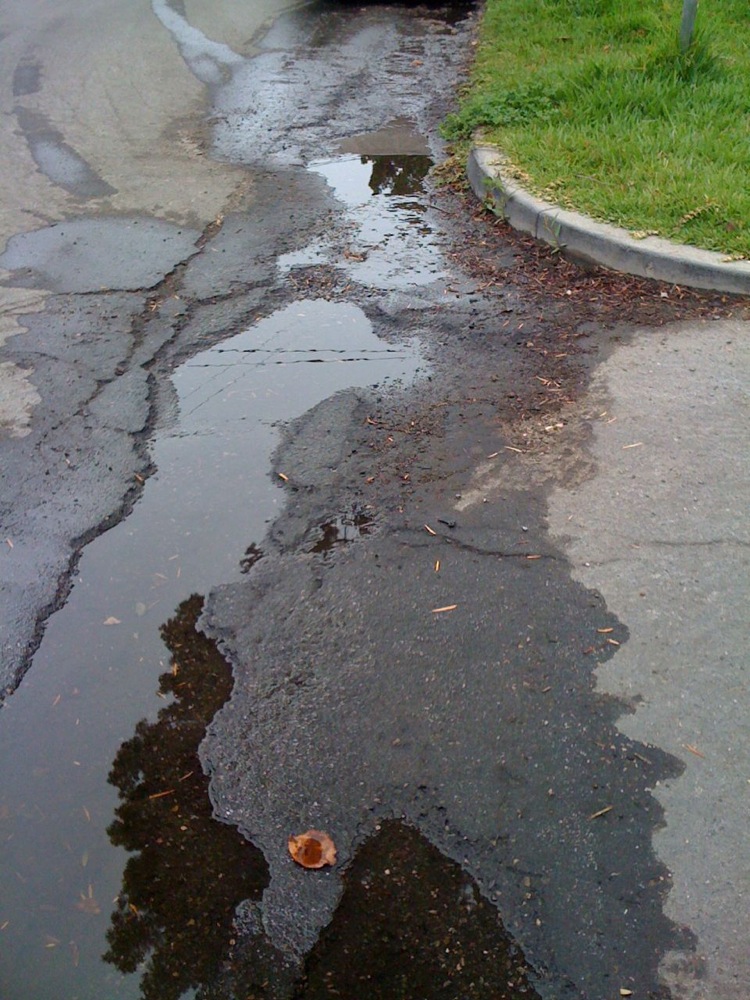
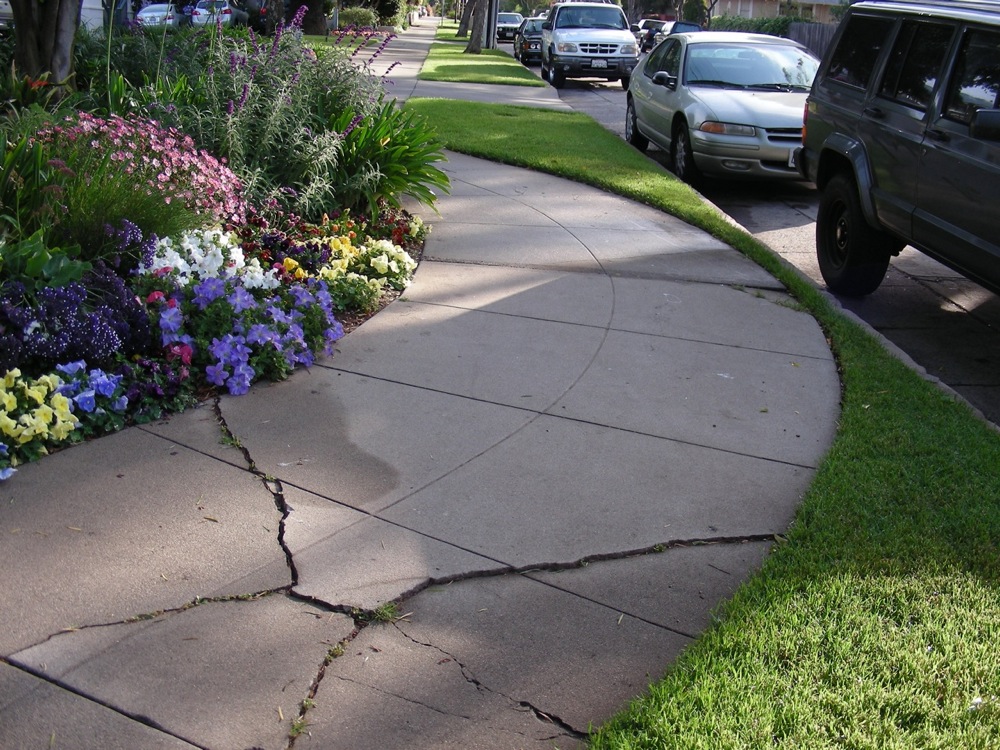
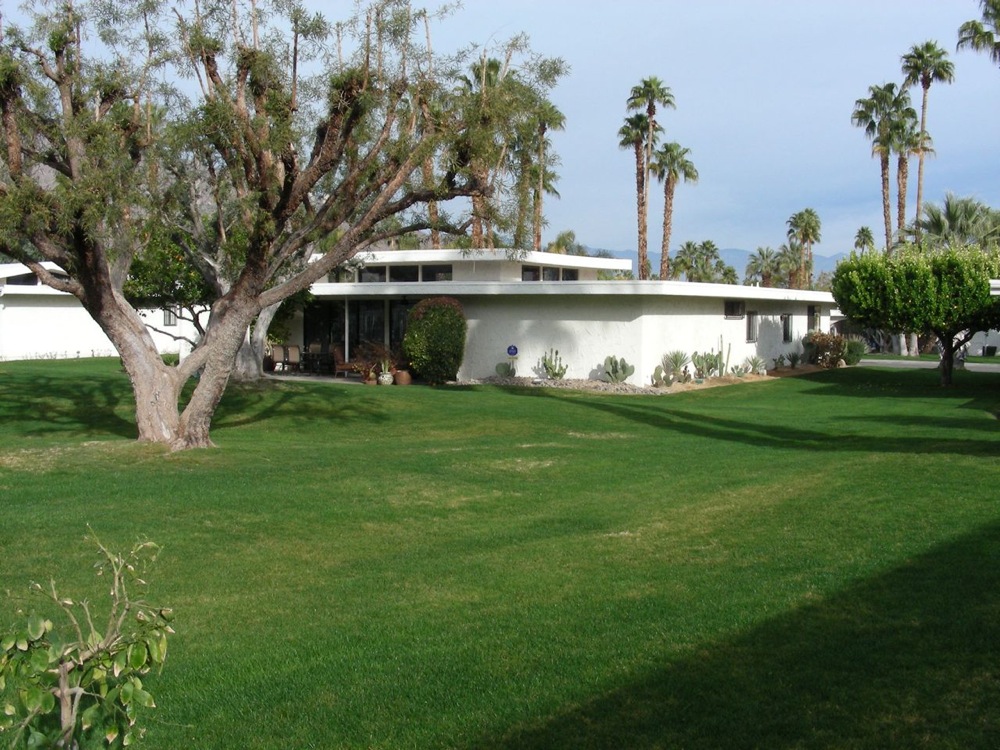
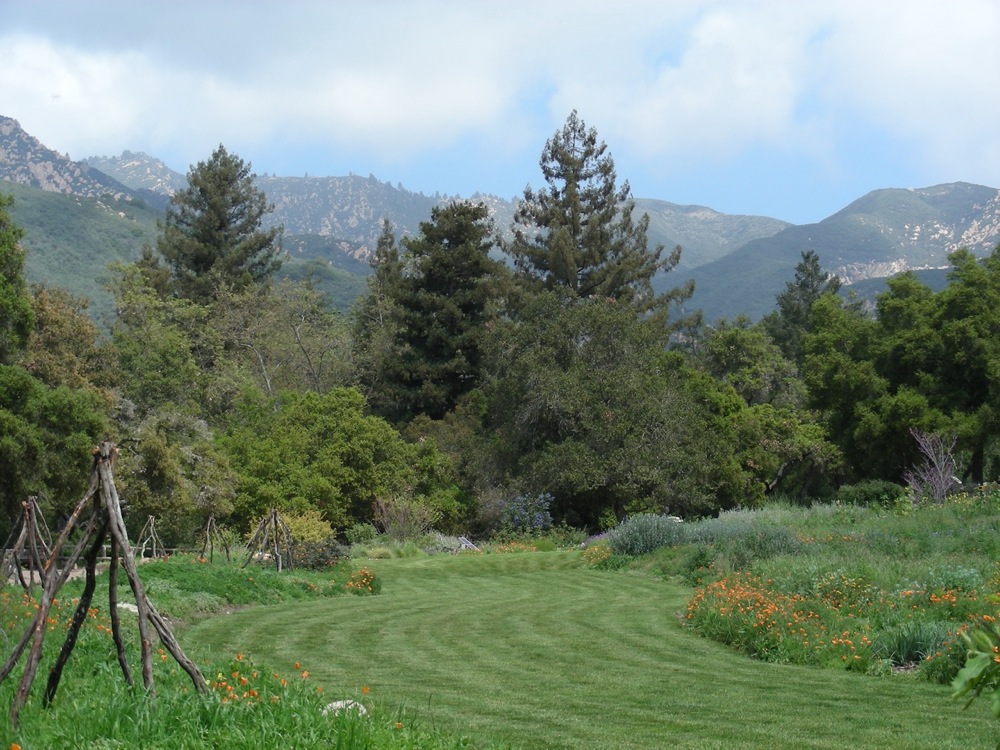
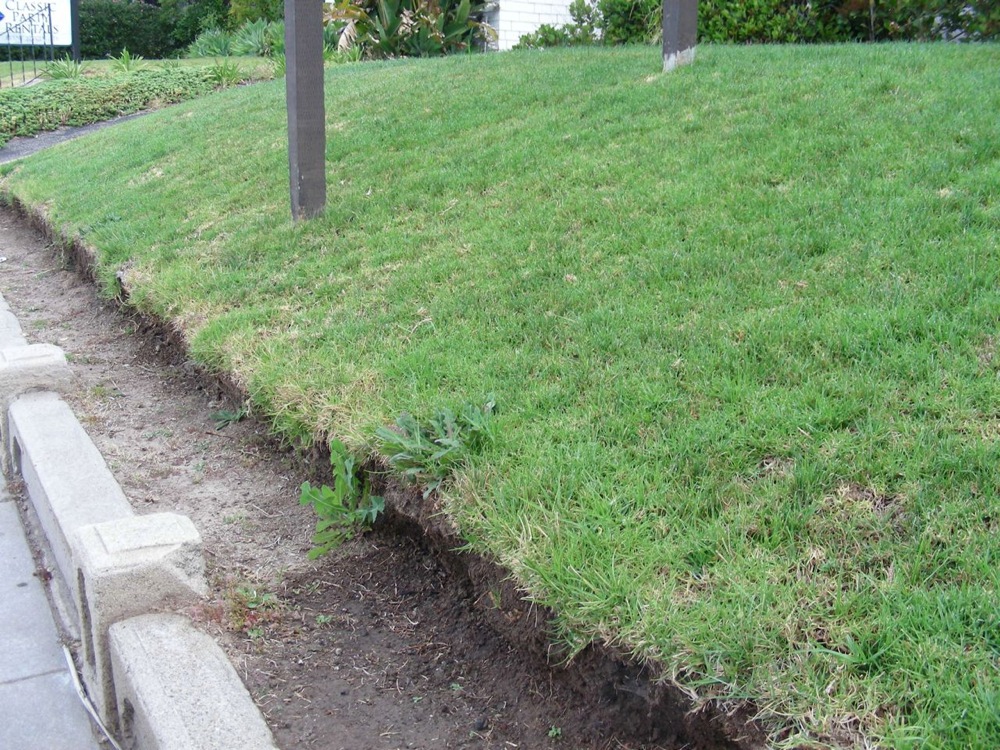





Road rage: A motorist’s uncontrolled anger usually provoked by the behavior of another driver. The affliction is officially recognized in the Diagnostic and Statistical Manual of Mental Disorders. “Water rage”, however, is not yet listed. But if it were, I’d probably be the poster child.
Recently, Biff the Wonder Spaniel and I were on dawn patrol when lo and behold, I spotted a sinuous finger of water rushing down the gutter, leaves riding the surge like a white-water kayak run. As cooling as that image might seem on a warm summer morning, I could feel my body temperature ratchet up and my pulse quicken. Images of an 8-ply, non-kink, heavy-duty, all-weather garden hose noose danced in my head—a textbook symptom of water rage.
 |
| The sight of wasted water gets my blood boiling. |
The motel three blocks up the street was at it again, watering the four-foot wide strip of turf between the curb and gutter. 1950s-vintage sprinklers sprayed halfway into the street. To top it off, the gardener was hosing down the driveway, thumb pressed over the opening, stubbornly coaxing a few soggy leaves toward the gutter.
What a waste.
I became a water conservation zealot in 1977 while working in a retail garden center. The West was experiencing its driest single year on record, water rationing was in full swing and dead lawns were the norm. It occurred to me then that all the azaleas, camellias and ferns we typically sold had no business growing in our semi-arid climate where average rainfall was 18”. I became a water-wise plant expert nearly overnight.
Thirty-plus years later, I’m still spreading the word through my classes, writing and television show. And thirty years later, many people still don’t get it.
In my last Fine Gardening blog (When The Well Runs Dry), I set the stage for why water conservation needs to be on everyone’s mind, whether you live in a historically arid gardening zone or not. It has to do with the uncertainty of climate change.
Take Action
There are many ways to promote water conservation. Perhaps the most effective is to become involved with local policy-making. Show up at the often sparsely attended board meetings of your local water agency and let your voice be heard. Tell them that the policies they make have long reaching effects on your community, the local economy and your property value. Warning: This path is not for the meek. The laws and historic rights that surround water are complex and often unfathomable–they can make your head spin around and explode like a Warner Brothers cartoon character.
Note: I’m directing these first few tips at those who need to irrigate their lawns. If you live in a climate where rain is plentiful and falls just when you need it, you can go pour yourself a frosty glass of something, but don’t go away.
Lawns
 |
| Palm Springs, where summer temperatures reach 120 deg. Imagine the water bill in this desert community. |
I have a reputation as a lawn hater, but really, I’m not a zero tolerance kinda guy. Lawns are the most appropriate “floor” for outdoor recreation. I mean, really, try kicking a soccer ball across an expanse of junipers. It ain’t gonna happen.
I do, however, have a problem with using turf grass as a strictly ornamental ground cover. In a typical Mediterranean climate like mine, a 1000 square foot (20’ x 50’) lawn uses more than 60,000 gallons of water in a year. Dumping that much precious, potable water on a boring swath of uniformly green grass borders on ridiculously wasteful.
Tip #1: Downsize
If you do need some grass in your landscape, consider downsizing. How much grass does it really take for the kids to burn off a little energy or to throw a saliva-soaked tennis ball for Fido? Picture a “lap lawn”—sort of like a lap pool. Narrow your existing lawn on two sides and substitute low-water using plants along the edges and you’re on your way. If you can resize that 1000 s.f. lawn to 15’ by 30’ you will cut your water use by more than forty-five percent. Pretty painless.
Tip #2: Substitute
Consider swapping out your thirsty fescue or bluegrass turf for a less demanding species. Here in California’s coastal areas, more and more people are achieving great success with native sedges like Carex praegracilis and C. subfusca, or super-drought tolerant grasses like UC Verde buffalo grass. These alternative turf varieties use about half the water of traditional grasses and can be mowed or left “fluffy.”
 |
| The lawn at the Santa Barbara Botanic garden is a blend of buffalo grass and native sedges. This turf typically uses 50% of typical lawn irrigation. |
For lawn alternatives in other parts of the country, read Susan Harris’s posts at Sustainable Gardening Blog. Her explanation of lawn alternatives is a must-read and includes delightful pics of her own backyard conversion.
Tip #3: Replace
If you don’t need a lawn for recreation, consider replacing it completely. That’s right, no grass at all!
[I’ll wait while you splash your face with cold water. La, la, la…my, oh my, lovely day we’re having. What about those Mets? Hmmm, what shall I do with all that rhubarb the neighbor gave me…]
You’re back? Good, take a deep breath and let’s move on.
What could be more rewarding and water-conserving than a quiet “reading room” with a luxurious chaise lounge, a colorful and fragrant butterfly garden and a hummingbird feeder to keep the local wildlife quenched?
Grow Food
With the cost of food rising and people’s increasing desire to know where their food comes from, more and more families are putting their land to a higher use. Modern day victory gardens are sprouting faster than radish seeds. Orchards are popping up everywhere and kids are actually eating fresh fruit again!
Growing food doesn’t always translate to big water savings, since we have to irrigate most crops. I don’t know about you, but if I’m going to pour a few thousand gallons of water into the dirt, I’d sure like to get back more than a place to breath in the fumes from a smelly lawn mower.
Getting Started
 |
| Parkway strip at the motel. There is no way to efficiently water narrow strips without overspraying to the sidewalk and street. |
When a sage philosopher said, “The longest journey starts with a single step” I don’t think they were talking about conserving water, but it fits. Whether you are motivated by the altruistic desire to help the environment or the pragmatism of reducing your water bill, take this first little step: Perform a water audit.
Check with your water agency and see if they provide a free check-up. Someone will come to your home (duh, you can’t exactly bring your landscape to them) look for leaks, help you adjust your sprinklers and controller, or just give you tips on the best management practices for your particular situation.
 |
| Inefficient to water, impossible to mow and just plain ugly. |
If you don’t have a free service available, check with your local irrigation supply store and see if there are local landscape contractors who provide system reviews. The payback for the service will come quickly as your water bill drops.
And if all else fails, I did a quick internet search and came up with a few thousand hits for do-it-yourselfer water audit instructions and kits.
Next up: Slick new technologies, gizmos and gadgets to help you manage your water use.
As for the water-wasting motel, I’ve sent them a politely written plea to consider a few changes to their irrigation system and technology. Although the common dictum of “any publicity is good publicity” is appealing, I’m not interested in being featured in the next edition of the Manual of Mental Disorders.
PS: If you’d like to see a zany, madcap music video about the joys of lawnicide, click over to YouTube for my little project with Owen Dell, co-host of Garden Wise Guys TV. I’m the guy in the flamingo-colored jacket.

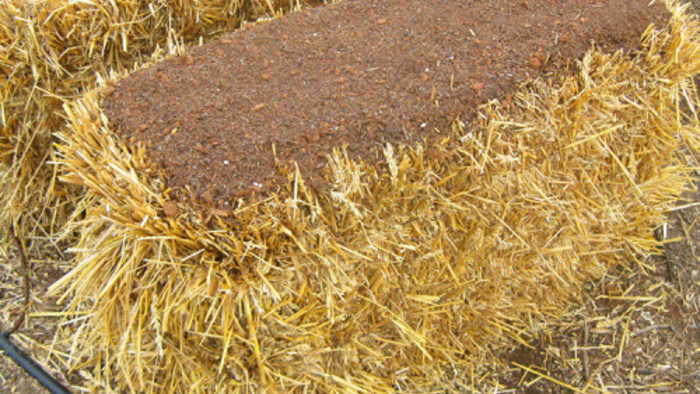


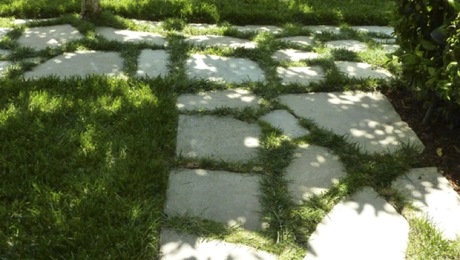












Comments
Excellant article!
When I see that in Las Vegas, and it happens more times than not, I will call and let the city know where it is.
They are getting to know me now...I don't know if that is a good thing though...
It is a good list of choices for alternatives to lawns. But my question is; how does one get rid of nutsedge organically without using a toxic chemical? If I could figure out how to rid my yard of nutsedge I might consider removing the lawn. The lawn is CAMOUFLAGING the nutgrass right now. I do not wish to be a slave to handweeding nutgrass as I already busy with that task in the flowerbeds. If one has a large area, it is too daunting to think of days of weeding. I don't need the grounds pristine but would like a manageable prospect.
Well done! For someone with that strong an aversion to turf, you put it very well! I'm defensive about lawns because the anti-sod retoric is really winding up, and I still see appropriate use for it occassionally. My expression is, "you can't play catch in a cabbage patch." So, I agree with everything you wrote, but you left a pair of really important options off the list, bioswales and rain gardens. If people are going to continue to pour water on their property - and let's face it, they are - the addition of a bioswale or raingarden provides a means of collecting it onsite and letting it soak back in to the ground instead of down the drain.
ValleyGardener: My heart goes out to you and your nutsedge problem. It's a demonic, invasive, tenacious garden pest. When I worked for the Santa Barbara Parks and Recreation Department it was the bane of our existence and frequently threw in the towel, gave up on ornamental beds, called them "lawns" and started mowing.
I checked with my good buddy, Owen Dell, author of Sustainable Landscaping for Dummies and cohost with me on Garden Wise Guys, a regional TV show we write and perform. Here's Owen's solution. Seems viable but not without compromises and costs.
~~~~~~~~~~~~~~~~~~~~
From Owen:
OK, the magic bullet is Tyvar 3631 6 oz./sq. yd. Spunbond Geotextile. We purchased it in 2003 from Reed & Graham Geosynthetics, 408 947-4290. It cost $575.00 per 4,500 sq. ft. roll including freight. It has no UV protection, so it needs to be covered with mulch. It lasts about 5 years, after which time the nutsedge should be history.
We also relied on information found at http://www.ipm.ucdavis.edu/PMG/PESTNOTES/pn7432.html, which goes into all the control methods and lists two other Typar fabrics. (I know, I know. Typar is made from cr*p and manufactured by a really sucky corporation and we are getting into bed with evil here, but hey, the only other alternatives are wicked chemicals (not very effective), a good real estate agent and a move to Milwaukee, or suicide. You get to choose. And although I haven't tried sheet mulching for nutsedge, I doubt it would be effective against this most aggressive of plants.
One other thing. We found that it was important to keep the nutsedge from coming up at the base of the plants, where the stems penetrated the fabric. To achieve that, we placed a Typar shield around all plants. [Note: Owen offered to print out the drawing of how to make the shield, but I let him off the hook - CGG]
Bottom line? It worked. The client was very good about pulling nutsedge whenever it showed up at the base of the plants (the shields helped but of course there was still a gap there and it was inevitable that some nutsedge would find its way through). Otherwise there was no growth of nutsedge through the fabric and it eventually died. Keep in mind that this was a frighteningly vigorous stand of nutsedge in Carpinteria where everything grows twice as big and twice as fast as it does here in SB.
Is this organic? Not if you're opposed to using a geotextile. But I don't have any better ideas, and at least it doesn't rely on herbicides.
Thank you for your "death to nutsedge" advice. I am thinking the cost would be too great to do the Geotextile/mulch for my space. I might consider Milwaukee if the nutsedge still came through the fabric after all that! Luckily I only have it in the front yard and not in the backyard but being located on a corner lot, there is alot of territory. I have replaced one side of my corner with rhaphiolepis, salvia, teuchrium, and bearded iris and have kept some of the nutsedge at bay but it is always there. My neighbor used a chemical and I just hate to go that route.
I will keep reading the blogs and hoping for the best.
valleygardener, I'm further north than Milwaukee, but we get some pretty aggressive weeds here, too.
As Billy suggests, smothering your lawn (killing it to save it) is the only organic alternative to spending hours each week (or each day) pulling individual weeds.
You don't need fancy fabric, but you do need to be willing to cover your lawn (or part of it) for a year or two. That's a pretty extreme option for a lot of people, but I've enjoyed the results.
Billy, that same vein swells on my forehead when I see the little gutter streams. Inspired/outraged by the midday irrigation of Algerian ivy and eucalyptus on a freeway embankment, I've created a Facebook page (http://is.gd/1OkXX) where ordinary citizens can vent their water rage by posting pics of the crimes and hopefully shaming the perps into handling their — our — water a little better. Thanks for the great tips & alternatives.
THIS IS FOR VALLEYGARDENER ~ and all those good people who have NUTSEDGE WEEDS..... we live on an old creek bottom, with excellent soil, and EVERYTHING grows here! We also have lots of weeds. One is the Nutsedge. Never before have I experienced something like this weed from hell: it propagates rapidly by runners, by little white "nuts" formed on the roots, and also by grass seeds formed at top, if allowed to grow that long. My neighbor encouraged me to keep digging out ALL the weeds, and that eventually, they would go away. Yes, and no. What I have found is this: Yes, you must dig out the nutsedge, getting as much of the roots, runners, and plant material as you can. Do a small patch at a time. Road rage? Take it out on this weed... it will be GOOD for you!! As soon as your area is clear, amend your soil, rake it smooth and NOW IMMEDIATELY PLANT SOMETHING HERE. And, then immediately MULCH thickly over the soil. This is the secret: Nutsedge will emerge if given LIGHT!! Ta Da!! Light and moisture = nutsedge. So, plant your garden, and then watch over it with vigilance! As soon as those sedges come up, until they are about 3-4" tall, you can EASILY pull them out..so do it! Do not wait!
And just so you don't think I have it "all together": I have a huge bare spot in our garden, where we took out some established plants. We moved them out, and the nutsedge moved right in... took over while we were gone on Vacation ... and now I must begin again. Ahhhhhh..... my "therapy"!! So, now I get out my shovel, my 4-prong hoe, my big green trash can, and go to work, or play... because removing the sedge is only the first step... after that I get to plant again, and it WILL be very beautiful. Thank you God for giving me such rich and wonderful soil! It will grow anything and does. I just need to watch over it and take care of it and ENJOY the entire process. Hope this encourages you all.
Hey Billy!
Water rage indeed. Here in Los Angeles, we are thrown in jail for watering more than twice per week!
Your readers may be interested in following my trial test of the UC Verde variety of buffalo grass that was developed for arid climates = Los Angeles.
The claim that I am testing is that UC Verde is supposed to thrive with 70% less water than other popular lawn varieties for my area. My reports are weekly.
Check it out:
http://edenmakersblog.com/?p=1082
Thnks Billy.
Shirley
Shirley: The work you've been doing to gather first hand info about Buffalo grass will be a great benefit to all us Left Coast landscape folk. I applaud you for getting your hands into it. When you get some good data, let me know and I'll let all these fine folk at Fine Gardening in on the news.
Thanks for your comments and the great work you're doing on line and on TV. MWAH!
Billy - I so feel you on the WaterRage -- I do a silent burn inside every day I walk in my neighborhood, I'm surrounded my a small auto dealer, hotels, grocery stores, a community college, etc. all who think nothing of watering the sidewalk and their turf. Worst of all, IMHO, is the water-before-it-rains jerks. We had rain forecast all weekand and we got it (plus tornado and flashflood warnings) but were the springlers ever turned off? Nope - they went right on cheerily watering before-during-and0after the storms.
Kathy: One of my next posts will be about "smart controllers" that reset themselves based on real-time weather information. Eventually, that's what everyone will have. It just makes sense. thanks for your thoughts...Billy G
Thank you for keeping on with the "grass does not always have to be greener" alliance. For almost 20 years I mowed an acre (though I never watered it -- even during drought times the grass will simply go dormant). What a waste of time, energy, and gas. We then bought 4 acres right across the street and now have prairie covering the entire expanse except for immediately around the house, which is landscaped perennials and patios. My brother-in-law, who bought our first acre, continues to mow -- sometimes twice per week -- and also now waters religiously and has a chemical spray contractor visit 3-4 times per year. He often comments to me, "your yard would look so great if you mowed this or that section." (And I comment in reply that he's doing more harm than good.) The reason for all this harmful, wasteful maintainance??? CURB APPEAL. Most people simply cannot fathom anything other than tracts of green grass surrounding their homes.
One other comment: I seem to remember in the late 1970s or early 1980s one of the big chemical companies (maybe Monsanto ??) claimed to be coming out with a grass that would end the need to mow. This grass was supposed to grow to a max height of 2 to 3 inches. I can only imagine that John Deere, Toro, and other mower manufacturers might have had something to do with putting an end to THAT.
I only wish my neighbor would read this. The San Francisco Bay Area is in the middle of a drought and she waters her post-stamp sized lawn 30 minutes, twice a day, then washes down her driveway, sidewalk, porch and her half of the road (yes, that's right - the asphalt road in which cars drive on) daily. Drives me bonkers. I come home to a river forming in my road and just want to scream. Maybe I should print this out and tape it to her door.
Thanks for the tip on the buffalo grass. I will admit to having front lawn and want to replace it with something that's more suitable.
Fabulous post, Billy, and thanks for the referral! Here's another place readers can look for lawn alternatives for wetter climates: http://www.sustainable-gardening.com/lawnsubstitutes/
Also, to FG? Smart move getting Goodnick on board. Great blog.
I live in a northern Ohio suburb on Lake Erie where manicured lawns are expected. My back yard is huge, and I am working to expand my gardens and decrease the amount of lawn there, while leaving enough to exercise my big, energetic weimaraner. :-) My front lawn has been decreased by expanding the perimeter gardens surrounding the house and adding an island, all with trees to provide more shade and reduce pressure from the summer sun. Three years ago, I had my front lawn replaced, due to an invasion of violets that, while pretty in the spring, completely took over. I learned about a Kentucky blue variant from Scott's that was developed in Texas to take more sun and summer heat. Wow! Since that first year of watering to get it established, it hasn't seen a hose, nor has my back yard. In spring, I allow the lawn to reach four inches (max allowed in my community) to get the root system well established, then keep it mowed to three inches. The grass has become a thick carpet. We often go 10 days or more without rain here, and it does wonderfully fine -- sometimes browning just a bit but comes back right away. I've put most of my hoses in a garage sale and water my container plants with a watering can. Former summer water bills ran around $90-$120. I now pay about $37 to $42 a month. Pure, fresh water is such a precious gift. So if you live in a community that demands grass lawns, this, too, is another choice.
Note to CoolGreenGardens regarding Owen Dell's recommendation for laying landscape cloth to deter nutsedge: I read some years ago that laying six (6) layers of black-and-white newspaper (which, today, no longer uses inks with lead in them) over the area, then putting several inches of mulch on top, will smother weeds. I have done this in my front gardens, and it works wonderfully. Over time, the newspaper will break down, back it its "organic" self. Just a thought to save money and be more natural in the garden.
Do not ever think of coming to Puerto Rico, USA.
Down here pipes and water meters broken...spill millions
of gallons all over the island in plain sight. And NO ONE
worries. As if water will be there for ever.
Lawns? I hate them for the waste of water, energy, pollution
required to keep them. Lawn are the greatest way to destroy nature, particularly in GOLF. However golf is so cute for some...
We will have to deal with lawns with the same harshness smokers and tobacco manufacturers have been dealt.
My husband get incensed at fundraiser car washes going on all spring and summer. All that water, soap, and road dirt going down the gutters to Puget Sound. The mechanical car washes recycle their water.
In 1996, after years spent on research and condition, Masai Barefoot Technology was perfected enough to be launched on the call Model Swiss, Muller developed the mbt technologies that would prevail upon accepted instability of soft terrain in place of sample Korean paddy tear fields or perhaps the East Africa savannah open also to people, who may partake of solely to walk nearby challenging floors In spite of men, there are discrete types of shoes like loafers, clogs, sandals, sneakers [url=http://www.onmbtshoes.com]mbt shoes sale[/url] shoes etc There are number of MBT shoes for women displayed on the website s From developing muscle tone to decreasing the incidence associated to offence, these shoes could possibly be considered a whole whole masses a whole lot more undeserved, but very much a whole whole loads more athletes are looking into utilizing them with regard to instruction coupled with always wear
Log in or create an account to post a comment.
Sign up Log in